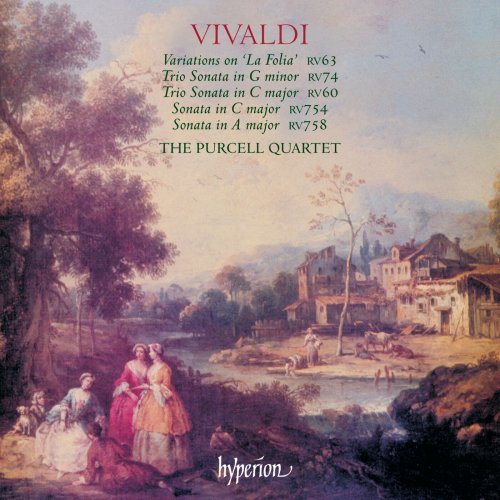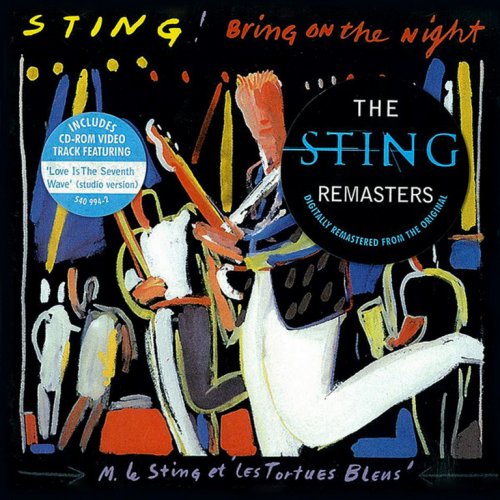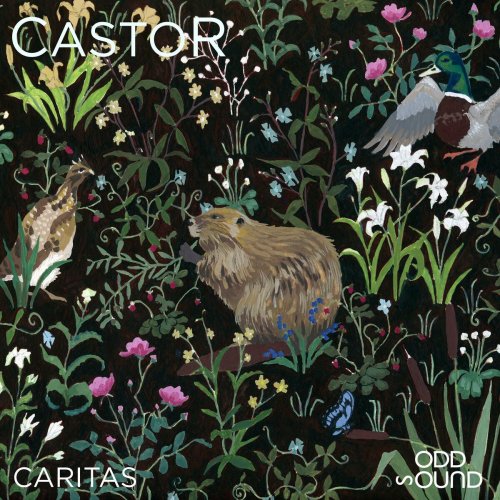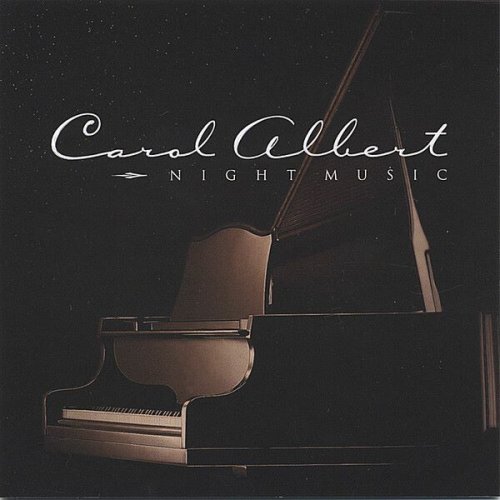Purcell Quartet - Vivaldi: La Folia Variations & Sonatas (1987)

Artist: Purcell Quartet
Title: Vivaldi: La Folia Variations & Sonatas
Year Of Release: 1987
Label: Hyperion
Genre: Classical
Quality: flac lossless (tracks) +Booklet
Total Time: 00:52:18
Total Size: 275 mb
WebSite: Album Preview
TracklistTitle: Vivaldi: La Folia Variations & Sonatas
Year Of Release: 1987
Label: Hyperion
Genre: Classical
Quality: flac lossless (tracks) +Booklet
Total Time: 00:52:18
Total Size: 275 mb
WebSite: Album Preview
01. Sonata for 2 Violins and Continuo in G Minor, RV 74: I. Andante
02. Sonata for 2 Violins and Continuo in G Minor, RV 74: II. Allegro
03. Sonata for 2 Violins and Continuo in G Minor, RV 74: III. Andante
04. Sonata for 2 Violins and Continuo in G Minor, RV 74: IV. Allegro assai
05. Violin Sonata in C Major, RV 754: I. Preludio. Largo
06. Violin Sonata in C Major, RV 754: II. Allemanda. Allegro
07. Violin Sonata in C Major, RV 754: III. Sarabanda. Largo
08. Violin Sonata in C Major, RV 754: IV. Corrente. Allegro
09. Sonata for 2 Violins in D Minor, RV 63 "Variations on La Folia"
10. Violin Sonata in A Major, RV 758: I. Preludio. Largo
11. Violin Sonata in A Major, RV 758: II. Corrente. Allegro
12. Violin Sonata in A Major, RV 758: III. Andante
13. Violin Sonata in A Major, RV 758: IV. Corrente. Presto
14. Sonata for 2 Violins and Continuo in C Major, RV 60: I. Allegro – Adagio
15. Sonata for 2 Violins and Continuo in C Major, RV 60: II. Allegro
16. Sonata for 2 Violins and Continuo in C Major, RV 60: III. Adagio
17. Sonata for 2 Violins and Continuo in C Major, RV 60: IV. Allegro
Every music lover is familiar with Vivaldi’s concertos, and to such a degree that the better known among them, notably The Four Seasons, receive almost too much exposure in the concert hall and in recordings. In contrast, his sonatas are little known and none too often performed. The reasons are various. Chief among them is the general awareness, perfectly correct as far as it goes, that Vivaldi’s concertos were ‘progressive’ in a historical sense, blazing a trail for others to follow, whereas the sonatas were ‘conservative’, content to follow the path laid down a generation earlier by Corelli. Logically, these factors ought not to influence our appreciation of musical worth, which can be expressed just as well in a traditional as in a revolutionary mould, but we have become so conditioned by an evolutionary view that it is hard not to equate the ‘good’ with the ‘forward-looking’. Another advantage possessed by the concertos has been the fact that in the shape of the string orchestra, augmented by harpsichord or organ continuo and the required soloists, the appropriate performing body has always been readily to hand, while permanent chamber ensembles formed specifically for the performance of baroque music have been rare until quite recently. Further, the association of Vivaldi with the subtle and imaginative use of instrumental colour has naturally favoured the orchestral works, whose inbuilt scope for special touches is so much greater. The last point of comparison is purely quantitative: as against nearly five hundred concertos there are only ninety-odd sonatas—though the second total would appear impressive enough in another context.
Twenty-seven of the sonatas fall into the category of the trio sonata, so called because the counterpoint is largely, often wholly, in three parts. In actual fact, the most common number of performers for a trio sonata was four: each of the upper two parts was taken by a single player, while the bass was shared by a melody instrument such as the cello and a harmony instrument such as the harpsichord. Sometimes the cello line momentarily diverges from the basso continuo proper supplied by the harpsichord, but this does not occur in any of the three trio sonatas in the present recording. From the very beginning of the baroque period around 1600 the trio medium held pride of place in the sonata literature: it was accorded the same kind of ‘canonical’ status that the string quartet enjoyed in the age of Haydn and Mozart. For this reason, ambitious young composers often made a point of opening their series of published collections with twelve trio sonatas, Op 1. Corelli did this in 1681; likewise Vivaldi’s most important older Venetian contemporaries: Vinaccesi (1687), Caldara (1693), Albinoni (1694) and Gentili (1701).
The earliest known edition of Vivaldi’s first opus, which he titled Suonate da camera a tre, appeared from the Venetian printer Giuseppe Sala in 1705. Rather surprisingly, the title-page acknowledges Vivaldi’s clerical status (he was ordained a priest in March 1705) but makes no mention of his post as violin teacher at the Pio Ospedale della Pietà (the Venetian institution for foundlings famous for its all-female orchestra and choir), to which he had been appointed in September 1703. Another surprising omission is the coat of arms of the noble dedicatee, Count Annibale Gambara, replaced by the printer’s own emblem. A possible explanation of both omissions is that the 1705 edition was a reprint of a lost original edition that came out in mid-1703, though this is highly speculative.
The twelve works in the collection are styled as chamber sonatas—that is, sonatas intended for domestic use, including performances at private concerts, rather than for use in church. Corelli in particular established the norm according to which chamber sonatas consisted primarily of stylized dance movements, often introduced by a preludio. Yet it was also Corelli who suggested an occasional alternative to this plan by casting the last of his Op 2 chamber sonatas (1685) as a single movement in the form of a chaconne. Similarly, the last of the six chamber sonatas included in his Op 5 violin sonatas (1700) is another variation movement, which takes as its theme the famous tune (and supporting harmonic framework) known as La Folia. Although this theme, of Spanish origin, had during the seventeenth century appeared in dozens of arrangements, this was its first taste of the exalted world of the sonata.
Vivaldi was one of several composers who tried to emulate Corelli. A comparison of his Folia sonata—the Trio Sonata in D minor RV63—with the older master’s reveals many similarities, especially in the choice of virtuosic figurations. Naturally, Vivaldi takes advantage of the extra violin to engage in exciting imitative play.
The stringed instrument prescribed for the bass in Op 1 is named violone. Some German musicologists have identified this instrument with the double bass, which is certainly what it was in the mid and late eighteenth century. However, Corelli was following an older Italian usage which described as violone the cello in its original, slightly larger form suitable for continuo work. The full size violone, which could not compete in agility with its smaller counterpart, was already becoming rare in Vivaldi’s time, and there is every justification for using an ordinary baroque cello in performance today.
The remaining trio sonatas in this recording, numbered RV60 and RV74 in the standard catalogue of Vivaldi’s works by Peter Ryom, both exist only in single, non-autograph manuscripts. RV74 comes from a collection originally formed by the Lund church musician Christian Wenster around the middle of the eighteenth century and today preserved in the library of Lund University (Sweden). RV60 belongs to the library of the Counts of Schönborn in the castle of Wiesentheid (Germany). Although both collections contain several works by Vivaldi that are undoubtedly genuine, a question mark must hang over the authenticity of both works on general stylistic grounds. Misattributions of authorship, both innocent and deliberate, were so common in the eighteenth century that it is very risky to prefer the evidence of a composer’s name written on a single manuscript by a copyist or collector to contrary indications of a musical nature.
The C major trio sonata, RV60, is the more doubtful. In particular, the second Allegro, a rather stiff fugue, seems more German than Italian in inspiration, while the ensuing Adagio, in which the two violins play in unison throughout, presents a texture totally uncharacteristic of Vivaldi. This is not to deny the vigour and effectiveness of the sonata. The G minor sonata, RV74, is a less clear-cut case. This contains features such as the canonic imitation between the violins in the opening Andante and the syncopations of the gavotte-like final Allegro assai that recall the Vivaldi known to us. Perhaps the benefit of the doubt is justified in this instance.
Vivaldi’s extant sonatas for one melody instrument and bass—‘solo’ sonatas as they were commonly known in his day—number over sixty. Twelve were published in 1709 as his Op 2 and four more in his Op 5 (1716). Most of the remainder, of which all but a few are for violin just like those in the published collections, survive in manuscripts dispersed here and there, but a group of twelve copied out under the composer’s supervision in a handsome volume are today found in the Henry Watson Music Library, Manchester. The volume once belonged to the collection of Cardinal Pietro Ottoboni (1667– 1740), the noted patron in Rome of Corelli, Handel and many other musicians. Vivaldi came into contact with Ottoboni during the carnival seasons of 1723 and 1724, when he was in Rome to direct his operas, and may have renewed direct links when the Cardinal revisited his native Venice in 1726. The extant fragments of the Cardinal’s collection, which also include manuscripts of twenty concertos by Vivaldi, prove how high Vivaldi stood in his favour during the 1720s. At present it is impossible to date the twelve ‘Manchester’ violin sonatas with precision, but ‘circa 1726’ seems a good estimate, provided that one remembers that this refers to the copying, not necessarily to the composition, of the individual pieces.
The relatively late period in Vivaldi’s career to which these sonatas belong is evidenced by the role of the bass, which no longer attempts, as in the earlier sonatas, to engage in thematic discourse with the upper part but is content to provide a firm harmonic and rhythmic underpinning. For its part, the violin line is more elaborate and finely nuanced than in the earlier works; its virtuosic figurations sometimes suggest the composer of the concertos. Vivaldi styled all the works as four-movement chamber sonatas on the Corellian pattern, comprising an opening preludio and three dance movements chosen from the traditional types: allemanda, corrente, sarabanda, giga and gavotta (an ‘abstract’ slow movement may be substituted for the second dance). Some of the dance titles appear merely cosmetic and introduced for the sake of uniformity; this suspicion is borne out by the existence of certain of the sonatas in earlier versions lacking those titles.
RV758, in A major, is the sixth sonata in the set. Its most striking movements are the two slow ones; Vivaldi styles the Preludio as a gentle siciliana and gives parts of the Andante a polyphonic feel by exploiting multiple-stopping on the violin. The fast movements are a bustling Corrente in 3/8 time and a second example of the same dance in a whirling 9/8. RV754, in C major, closes the set. Its most complex movement is the Allemanda, which manages to pack in an extraordinary variety of idiomatic figures. The Sarabanda lends welcome variety by adopting the key of C minor. Flowing quavers in 3/4 time characterize the serene Preludio; the concluding Corrente is an essay in thematic concentration, exemplifying clearly Vivaldi’s penchant for insistent, repetitive patterns.
This, then, is Vivaldi the sonata-composer. In his own day the sonatas certainly achieved less wide appeal than the concertos—they were aimed at the connoisseurs who frequented music societies rather than the broader layers of society found in the theatre or the church—but the frequent reprinting of Opp 1, 2 and 5 shows that they were not considered marginal. Today let us value them for their original sense of style and expression that cuts across all questions of ‘historical significance’ and allows us a more intimate view of their creator.


![Sleazy Grease - ...Thanks, Appreciate it (2024) [Hi-Res] Sleazy Grease - ...Thanks, Appreciate it (2024) [Hi-Res]](https://www.dibpic.com/uploads/posts/2024-06/1718433086_iobeyj7zu7zea_600.jpg)

![Emanuele Giunti & Cristiano Riccardi - Victory Parade (2024) [Hi-Res] Emanuele Giunti & Cristiano Riccardi - Victory Parade (2024) [Hi-Res]](https://www.dibpic.com/uploads/posts/2024-06/1718505411_cover.jpg)
![Kitflus & Kitflus Ensemble - Kitflus Ensemble 1 (2024) [Hi-Res] Kitflus & Kitflus Ensemble - Kitflus Ensemble 1 (2024) [Hi-Res]](https://www.dibpic.com/uploads/posts/2024-06/1718438218_folder.jpg)
![Mezzoforte - Monkey Fields (1996/2021) [Hi-Res] Mezzoforte - Monkey Fields (1996/2021) [Hi-Res]](https://www.dibpic.com/uploads/posts/2022-04/1650195299_coverx640.jpg)

![Tony Drake - Live at Milestone (2024) [Hi-Res] Tony Drake - Live at Milestone (2024) [Hi-Res]](https://www.dibpic.com/uploads/posts/2024-06/1718326330_pn7ip3txbiumb_600.jpg)